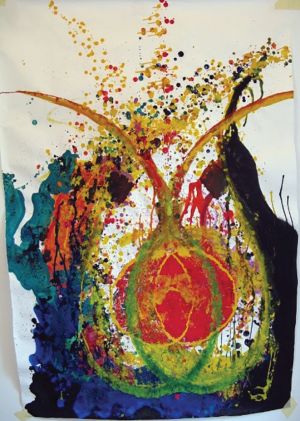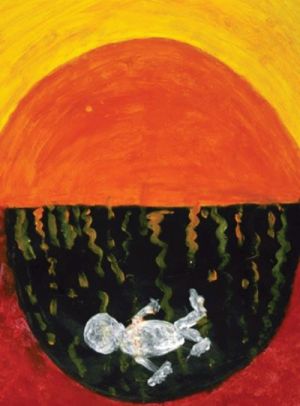Have you put something in my tea?’ asked Sylvia,* a client who came for support after her cancer diagnosis. She had arrived for her therapy session full of anxiety and despair. As part of the session, she was led through a guided exercise, ‘Imagery of a Good Place’. During her imaginative journey, Sylvia had experienced being in a beautiful garden. Now she was feeling euphoric. Days later, Sylvia reported experiencing a lasting sense of peace.
People who are confronted with cancer face innumerable challenges. Their fundamental feelings of security and having control over their lives are threatened, and their self-confidence, sense of meaning and wellbeing are often undermined. Such loss can create shock, panic, fear and anger. In addition, cancer patients face bodily impairment, chronic fatigue, scarring and other permanent physical effects of the disease and its treatment.
In the case of illness and crisis, imagery and artistic expression can help enhance one’s quality of life, strengthen a sense of meaning, improve interpersonal communication and reduce feelings of anxiety, fatigue, stress, pain and depression. In the case of cancer, clinical evidence shows that imagery and art can help to increase resilience.1 Internal imaginary experiences and expressions in any artistic form – such as drawing, writing, singing and dance – can revive a sense of autonomy and can activate healing resources.2


The ritual use of imagery and art has always been an integral part of human behaviour. It’s not only part of what makes us human, it plays a role in forming identity and the development of mental, social and physical skills.3 Sheikh and Assagioli, two of the most significant writers in the field of therapeutic imagery, both name imagination as a core function of the psyche. Sheikh defines imagination as the central arena within which the personal identity is formed, and also where access to deep sources of problem-solving can be found.4 Assagioli states that every image has within itself a drive that tends to produce the physical conditions and the external acts corresponding to it. In other words, by clearly imagining a possibility, we bring it closer to actualisation.5 In this way, imagery offers us a powerful source of inspiration, healing and inner freedom.


Within neuropsychology, the discovery of mirror neurons has confirmed the central role played by the imagination in learning processes, as well as in recuperation after injury.6 That which we perceive, imagine, paint, model or sing is represented and activated in our brain, and this stimulates corresponding behaviour. The advertising industry uses this psychological principle extensively, and motor imagery is applied widely in the world of rehabilitation and sport. Studies show that visualising a muscle moving can produce physical changes.7 Similarly, the many studies on the placebo effect have shown that expectations, such as imagining that ‘this pill helps’, can relieve symptoms and foster resilience and healing, even when the participant in the study has been told that the pill is a placebo.8,9
Resilience and healing
Human beings possess an innate self-reinforcing capacity, a healing potential that works through the imagination. Imagery therapy makes conscious use of this imaging power. In this type of therapeutic work, clients become deeply familiar with an image, to the point that the image becomes an integrated part of their inner world. Clients then discover that they can influence their images and apply them in their daily lives. The therapist’s role is to facilitate the client’s navigation of conscious and unconscious self-images, drives and potential talents, and stimulate their active application in daily life.
Techniques used in imagery work include observing and merging with an image, dialoguing with it, artistic expression, insight, emotional and bodily integration and application in daily life. The technique that a therapist chooses depends on the client’s process. Questions to ask include, what may strengthen the coping capacity and resilience of the client, and what needs to be further developed?


Potential pitfalls
Essential to the successful use of imagery is the degree to which the person feels comfortable with the images created and can integrate them. In other words, is the client able to own and master the images? This is particularly critical in the case of prescribed guided imagery. For instance, clients who compel themselves to imagine something positive while simultaneously repressing more negative feelings or images could be left with difficult emotions to process.
Only images that are fully accepted and well-integrated into a person’s personality and daily life tend to be beneficial and transformative. The therapist needs to avoid using positive healing images that might feel forced or uncomfortable to clients, especially in the case of those with a life-threatening illness. When fear of suffering and death play a major role in a client’s presentation, prescribing imagery that they cannot relate to can provoke strong feelings of tension, guilt and failure, as well as cause depression.
The spontaneous images of the person should always be the starting point. From there, the therapist can work on what the person needs and on the images and symbols that go with those needs. A major pitfall, however, is over-focusing on visualising physical healing. However much physical healing is, understandably, desired by the client and also by the therapist (countertransference), this focus makes the therapy limited. It is often the existential, spiritual essence of life that needs to be given heartfelt attention.
Imagery toolbox
Jan Taal is a psychologist and psychosynthesis psychotherapist with more than 40 years of experience of working with people with cancer and chronic illness. He and his colleagues at the Amsterdam School for Imagery developed the Imagery Toolbox, a collaborative, non-profit project, with the Cancer in Images Foundation.10
Taal and colleagues launched the Dutch-language edition 10 years ago, and it became available in English last year. It provides user-friendly tools, techniques, guided meditations and inspiration to support counsellors working with cancer patients to access wellness and inner healing.
A pilot study from the University of Humanistic Studies in Utrecht on the effects of working with the Imagery Toolbox found that it powerfully stimulates the imagination and mobilises the mental healing potential of the participants.11 A large research project on the effectiveness of the toolbox, a collaboration between the University of Groningen and the University of Twente in the Netherlands, is currently in its early stages.
The Imagery Toolbox includes a course book, symbol cards, an audio CD and MP3s with eight imagery exercises (including ‘Imagery of a Good Place’), a set of watercolour pencils, paintbrush and sketch book, modelling clay, a notebook and a DVD with two short films. All of these seemingly simple tools synthesise into a powerful collection of possibilities for the therapist to offer clients who might be suffering from illness or be in crisis. The course book also has a chapter explaining how family members can use art and imagery to help in the healing process and, if necessary, prepare for the death of their loved one and provide aftercare. Much of the material is available for free from www.imagerytoolbox.com.
In an era where the costs of healthcare are constantly increasing, self-reinforcing methods such as imagery and artistic expression are important additions to the care of cancer patients. When illness or crisis hits, we are often forced into an intimate meeting with ourselves, and both imagery and artistic expression can contribute significantly to promoting our inner and outer coping and resilience. Imagery and art provide a humanistic, individualised, empathetic and patient-centred response to this challenge.
*All the people in the case studies are pseudonyms and taken, with permission, from the work of Jan Taal.12
Next in this issue
References
1. Linz D. The effects of art therapy interventions in cancer care. Nijmegen: HAN University of Applied Sciences; 2014.
2. Fancourt D, Williamon A, Carvalho L, Steptoe A, Dow R, Lewis I. Singing modulates mood, stress, cortisol, cytokine and neuropeptide activity in cancer patients and carers. Ecancer 2016; (10): 631.
3. Morriss-Kay GM. The evolution of human artistic creativity. Journal of Anatomy 2010; 216(2): 158–176.
4. Sheikh AA (ed). Healing images: the role of imagination in health. New York, NY: Baywood; 2003.
5. Assagioli, R. Psychosynthesis: a manual of principles and techniques. New York, NY: Hobbs, Dorman & Company; 1965 (p144).
6. Keysers C, Fadiga L. The mirror neuron system. Hove: Psychology Press; 2009.
7. Mulder T. Motor imagery and action observation: cognitive tools for rehabilitation. Journal of Neural Transmission 2007; 114: 1265–1278.
8. Kaptchuk TJ, Friedlander E, Kelley JM, Sanchez MN, Kokkotou E et al. Placebos without deception: a randomized controlled trial in irritable bowel syndrome. PLoS ONE 2010; 5(12): e15591. doi:10.1371/journal.pone.0015591.
9. Enck P, Benedetti F, Schedlowski M. New insights into the placebo and nocebo responses. Neuron 2008; 59: 159–206.
10. www.imagerytoolbox.com
11. Alma H, Taal J. Verbeeldings Toolkit. Psychosociale Oncologie 2015; 23(1).
12. Taal, J. Course book Imagery Toolbox. Amsterdam: School for Imagery; 2017.
